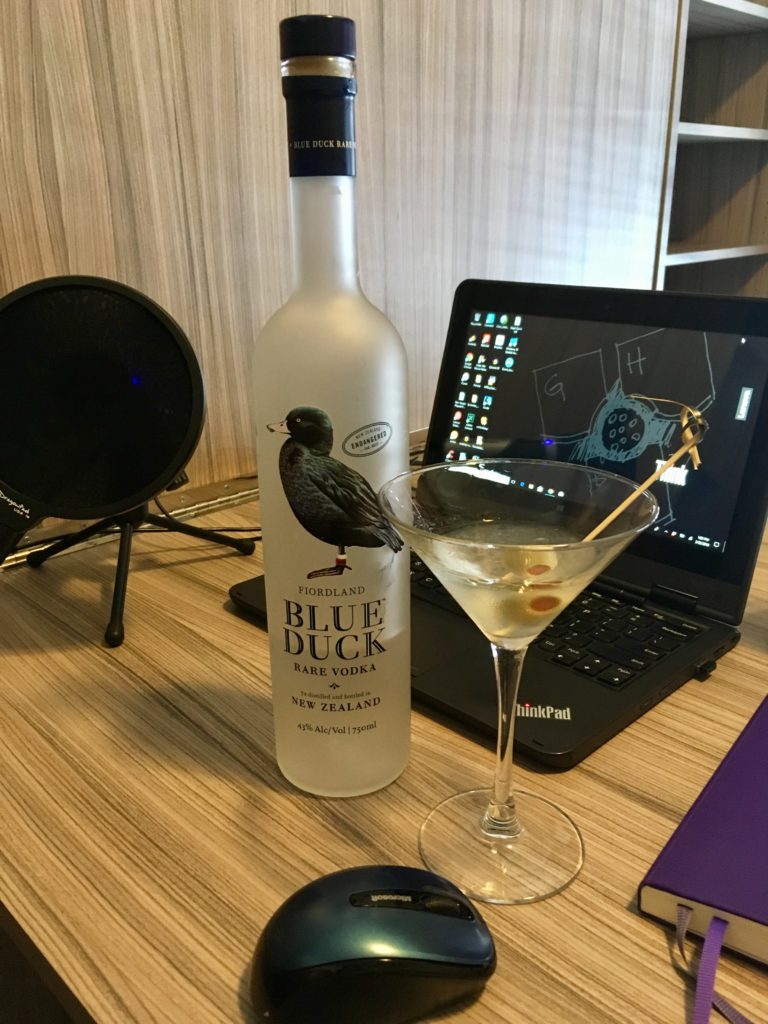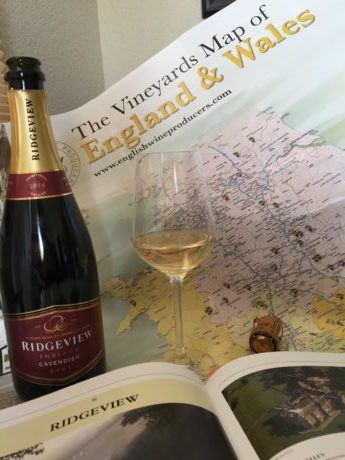Episode 151: English Wine & Bout of Bubble Banter
We answer a request for some edutainment about English wine, and found some cool resources on this cool climate country’s rise as a wine presence in the world, particularly where bubbly is concerned. Talk about wino radar! Also, the “proof” is in the factoid, and the ladies scare up a silly video for patron consumption.
In the Glasses This Week (1:24)
Steph: In the absence of English wine available locally, Steph bellied up to the bar and made herself a dirty, but not too dirty, vodka martini from the bottle of Blue Duck Rare Vodka she brought back from New Zealand. She talks about the significance of the rare native bird, and her experience in actually seeing a pair of them with Wildlight Safaris!
“The vodka is made from 100% pure natural whey, a by-product of New Zealand’s dairy industry. It’s distilled seven times and is one of the best vodkas I’ve ever had!” Steph says. We believe her!
Val: Cavendish Brut, 2014, Ridgeview Estate, Sussex, England. Ridgeview was founded in 1995, however. This is a sparkling wine made with Pinot Noir, Meunier, and Chardonnay.
English Wine Overview (4:35)
Why English Wine?
Because it’s there, and its popularity is on the rise, particularly the sparkling wine category. Also, because David, one of our dedicated supporters in Scotland, asked us. Therefore, we went there.
Overview (6:05)
Two thirds of English wine production is sparkling, and most of that is produced in the classic method.
We should add that to be classified as “English wine” the wine has to be made in UK wineries from grapes that are grown in England or Wales.
Otherwise, it’s “British Wine.” This means that although the wine is made in the UK, the grapes or juice could have been bought from other places, garner lower prices, and aren’t consider wine by EU definition regarding production.
However, only 5% is exported for now. This is on track to change over the next few years
Timeline (8:04)
We can pick up the English wine roots in the 1950s, although there are historical accounts of vineyards that date back to the 18th century that are still active today, such Painshill Place in Surrey.
Before that, however, we’d have to time travel back to nearly 1000 years to find a real viticultural boom. There is also a lot of discussion to be had regarding the climate.
“The Revival” began in the mid 20th Century.
The first modern vineyard was planted in Hambledon 1951.
In the 1980s, oak aging of wines became popular, but bottle-fermented bubbly was also getting a toehold at that time.
Blurbs ‘Bout British Bubbly (10:12)
We often offer a nod to the British for the stronger bottle glass that is partially responsible for cutting back on exploding Champagne bottles in the 17th Century. (See Episode 84)
Also, remember the story of Christopher Merret, who, shortly before that, created fizz on purpose. Christopher Merret was English, and the French were making sparkling wine by accident before this.
However, it seems the British have, several hundred years later, been recognized for producing their own classic method sparkling wines!
The first bubbly produced from vineyards in England was in 1976.
Ridgeview and Nyetimber were founded in 1995 and 1996, respectively.
However, Nyetimber is also credited for helping draw attention to English bubbly with their 2003 Classic Cuvee at the 2009 Italian Bollicine del Mondo (Bubbles of the world) competition for sparkling wines.
Ridgeview then came crashing onto the scene in 2011 with their 2007 Grosvenor Blanc de Blancs at the Decanter World Wine Awards.
Now sparkling wine makes up 66% of wine made in the UK!
Regions (13:22)
From what we were able to determine from online resources, there are seven regions (counting Wales), mostly concentrated in the south. South East, Wessex (including Isle of Wight), Thames and Chilterns (including Oxfordshire), South West (including Cornwall), Mercia, and East Anglia all boast wine regions.
There are over 500 vineyards, and more than 130 wineries. We honestly couldn’t scare up a good regional wine map, but you can order your own paper copy from the English Wine Producers website.
Grapes (18:29)
Chardonnay, Pinot Noir and Meunier account for about half of vineyard plantings
Red grapes also include Gamay, Rondo, Regent, Dornfelder, and Triomphe
Other white grapes behind Chardonnay include Bacchus, Seyval Blanc, Reichensteiner, Muller-Thurgau, and aromatic varieties such as Madeleine Angevine, Ortega, Schonburger, & Huxelrebe, among others.
Styles (19:40)
Besides sparkling wine, there is also some cool climate styles of wine produced, such as lighter reds, but these account for only 10% of wine production, along with rose’.
White wines comprise less than a quarter of wines produced in England, and vary in style from dry to sweet, including late harvest and dessert styles. As you can imagine, noble rot can happen here. These will have the lower alcohol and higher acidity consistent with cooler growing areas.
Learn More (21:00)
http://www.englishwineproducers.co.uk/ and Follow at @englishwine
https://www.thedrinksbusiness.com/2017/12/breaking-english-wine-body-becomes-winegb/
https://www.visitbritain.com/us/en/food-and-drink/beer-cider-and-wine
http://www.bibendum-wine.co.uk/content/article/view/doc/harvest-2017-england/
*(Note: Bibendum released a podcast about English wine, which we only discovered the week after this was recorded. Please check it out, as Ridgeview’s founder is part of the conversation – and they do “English” much better than these two Americans.)
English Wine Week, by the way, is during the last week of May. Follow @englishwineweek
Look to Stephen Skelton MW for expertise and his published UK Vineyard Guides.
Factoid (22:06)
This week’s factoid is about where the term “proof”, when referring to the strength of a spirit, comes from. This came up in the recent SWE webinar about American Whiskey with presenter Russ Kempton.
Extra tax was imposed on higher strength liquors in 16th Century England. The proof, or test if you will, of a distilled spirit was determined by combining equal amounts of whiskey and gunpowder, then applying a flame. Only when the flame burned evenly with a blue flame was it “proofed” or measured as strong and therefore taxed. When the gunpowder failed to burn, the whiskey was considered weak, and conversely, when it burned brilliantly, it was determined to be very strong.
Today in the US, the alcohol proof is twice that of the percentage of alcohol by volume (abv). Most other countries now use abv on their labeling and rarely do you see proof used.
Shoutouts (24:04)
We have a new listener, or in his words, a “fan club member”!
Phil sent us a lovely email:
“Dear Stephanie and Valerie,
I am a fairly long time wine aficionado…almost 25 years of being a wino. But I am a new listener to your podcast having just found your wonderful show this past week. You two really do a great job and a very professional job and just find listening to your podcasts are very enlightening and relaxing …You two really have great chemistry. Keep up the great work.”
Thank you Phil in Florida for reaching out to us.
Patreon Love (25:00)
Thank you to our Patrons who support us on the crowdfunding platform called Patreon!
“TENacious Tasters”
- Jeff E from the We Like Drinking podcast
- Lynn from Savor the Harvest blog
- Sebastian of Sassi Italy Tours
- Jen in Maryland (and the world, according to her Instagram feed)
- David and Lisa in Illinois
- Ann Marie in Virginia
“It’s not five o’clock and we don’t care” Listeners
- Meg in South Dakota
- Clay in Arizona
- In California – Jon, Andrew, Aswani
- Chantel in Ontario, Canada
- Mary Lou in Pennsylvania
- Cathie in Georgia
- In Colorado – Chris and Janet, Diane
- In Illinois – Steve, Renee
- Cathey in Tennessee
- Ashley in North Carolina
- Sean in Ohio
“Tastemaker Listeners”
- David in Scotland
- Carole in Kentucky
- Karen in California
Patreon perks (26:08)
Against our better judgement, we are going to make a basement performance of the extended version of the W25 Rap available, only to patrons at the $2/month level or higher, on March 1st.
Embarrassing wine stories? We’re owning it.
Connect: (27:46)
We’re here for you every week. Between episodes you can find us on the social spaces @WineTwoFive and we encourage you to join our private FaceBook group called Wine Two Five Community!
Connect with Val on Twitter @WineGalUnboxed and as Vino With Val on Facebook, Instagram & Pinterest.
Connect with Steph on online as @TheWineHeroine.

